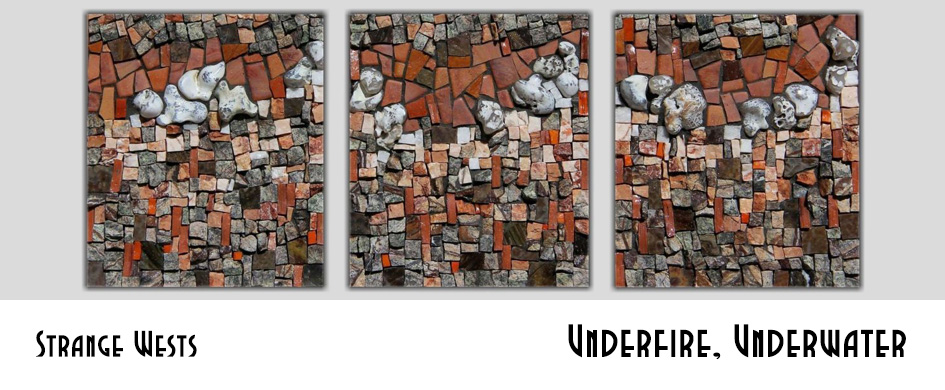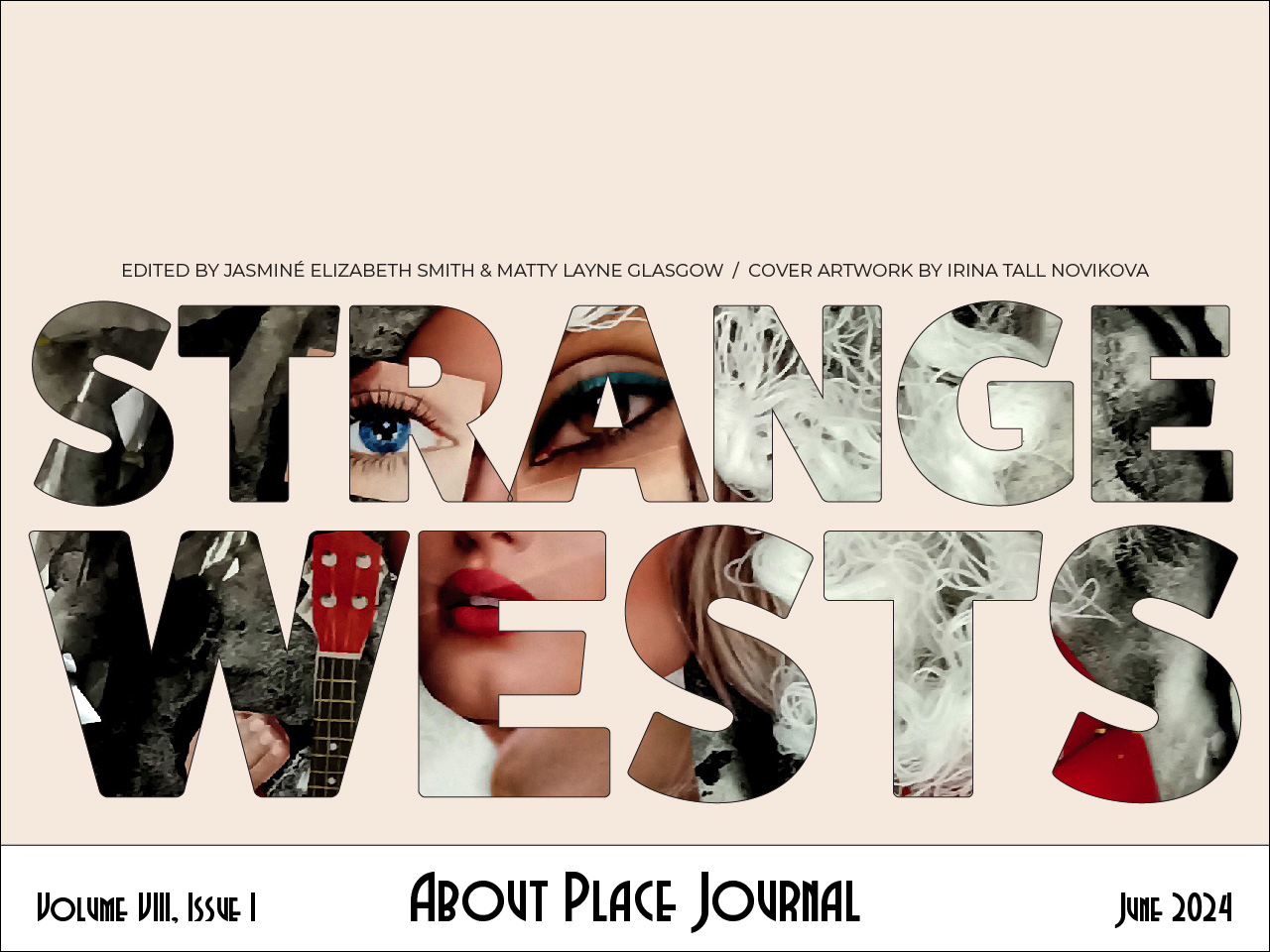(excerpted from Wild Chorus: Finding Harmony with Whales, Wolves, and Other Animals, by Brenda Peterson, Mountaineers Books, 2024)

Some children have teddy bears for companions and touchstones. My early childhood in the national forest cabin was filled with stories of Smokey Bear, a real-life survivor of the Capitan Gap Fire in New Mexico in the summer of 1950. This black bear cub was no fairy tale; he was a brave orphan found by firefighters near the fire line. The firefighters were also caught in the fire storm’s path, and they lay face down for over an hour on a rockslide as the fire burned over them. The cub had sought refuge by climbing a charred tree, but his paws and hind legs were singed, painfully. The firefighters rescued the cub, and one of the base camp’s cooks slathered the cub’s paws and legs with butter—some locals say bacon grease—before he was flown to Santa Fe, where his burns were treated by a New Mexico Department of Game and Fish ranger and his family, who cared for the cub.
As a child I’d seen vivid, scary photos of this bear cub curled up with his tiny paws in white bandages. Every time my own father went off to fight forest fires, I prayed that this little cub who was growing up strong would protect him and all the other wild animals from the flames. Animals and people on fire, running through a burning forest, their skin or fur aflame with red-hot, hungry tongues, was one of the most haunting nightmares of my childhood.
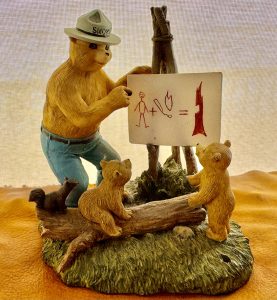
The Forest Service soon named the cub Smokey Bear, and he became an endearing and enduring symbol of fire prevention. The poster with Smokey pointing a scarred paw, “Only You Can Prevent Forest Fires” was burned into my consciousness. To this day, I have Smokey Bear swag—flannel sheets and salt-and-pepper shakers, T-shirts, and a giant stuffed teddy bear—reminding me of my duty to the forest and all wild animals. I am still afraid of fire and constantly nudge everyone to turn off Christmas tree lights, snuff out candles, stamp out campfires—anything that might burn down the house or forest. I am always reminding my friends when they trek off camping that nine out of ten wildfires are caused by humans.
Smokey Bear lives in me so deeply that when my father was Chief of the Forest Service, he asked me to write a kid’s book with Rudy Wendelin, illustrator of Smokey Bear. I still have those original drawings buried somewhere in my storage unit. In my first memoir, Build Me an Ark: A Life with Animals, I wrote the tragic story of Smokey Bear, who lived in the concrete caves of the National Zoo in Washington, D.C., until he died in 1976. How I had hoped as a child that Smokey would be rehabilitated and returned to the forest. It’s probably where my years of writing about wildlife restoration took root.
In the summer of 2021, I was transfixed when firefighters rescued another bear cub from the devastating Antelope Fire in the Klamath National Forest on the border of Oregon and California, only a few hours’ drive from my Plumas National Forest birthplace. Clinging to a tree near Antelope Creek, this cub was also badly burned. Eerily, the rescue was on the seventy-seventh birthday of the original Smokey Bear. Wildlife biologist Sarah Bullock found the young bear who had been either orphaned or abandoned.
Poignant photos of Bullock in her yellow hard hat holding the cub went viral, her hand cradling the bear’s paws. Especially poignant was the image of the cub hugging the base of a tree, his hind legs lifted just off the ground. With second and third-degree burns on his nose and paws, the 16-pound cub was taken to Gold Country Wildlife Rescue facility in Auburn, California, where he was attended to by veterinarians from my alma mater, University of California.
“He is eating well and taking fluids on his own, which the doctors consider a positive sign for full recovery,” news reports reassured those of us who eagerly followed the rescue.
Bullock and California Department of Fish and Wildlife biologist Axel Hunnicutt had first tranquilized the cub, and several drivers transported the injured bear 200 miles to the wildlife rescue facility. Gold Country Wildlife Rescue often receives animals found alive after wildfires, “with the ultimate goal of reintroduction into the wild whenever possible.” Unlike the original Smokey Bear, this young survivor of one of the deadliest Western wildfires had a chance to return to the forest.
This remarkable wildlife facility in 2021 rehabbed three bears from the Antelope and Dixie Fires. Their stories are not the stuff of Three Bears fairy tales, but of devoted wildlife rescuers, who work to heal the damage climate change has brought to the West with its devastating cycle of fire and floods. Photos of these three bears cuddled together in a wooden bunk are featured on the facility’s website. But sadly, when I wrote Gold Country Wildlife Rescue to inquire about the cub rescued from the Antelope Fire, they reported he did not survive. Two other burned cubs did live and were released in the spring of 2022, “deep in the mountain wilderness.”
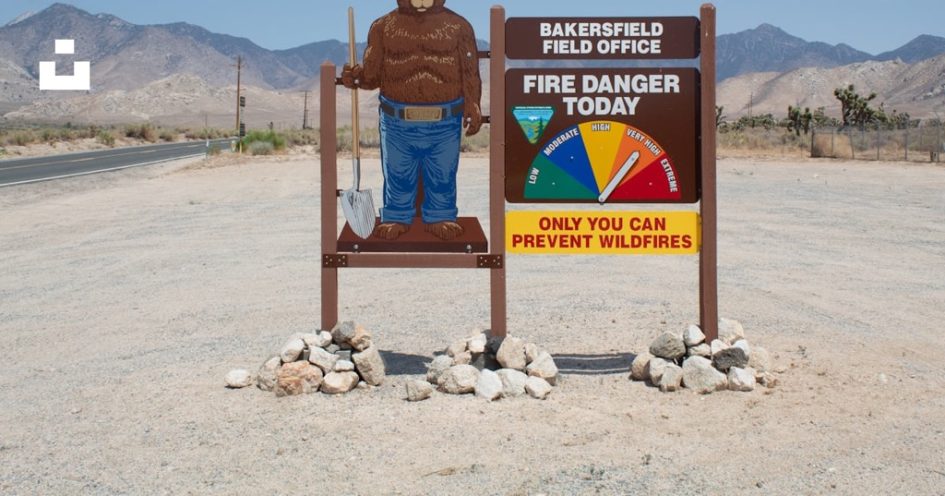
Smokey Bear has made a comeback now after Woodsy Owl and other Forest Services characters failed to capture the public’s imagination as much as that singed little survivor. Kids can still write Smokey Bear via Washington, DC 20252. Current television ads again feature a Smokey Bear character who is witty, as well as instructive, when advising us to always extinguish our campfires. This 21st century Smokey Bear has a lot to do to educate us as devastating wildfires consume Western forests. Smokey’s Only You campaign now includes environmental lawyers for states and cities. A Grist article in the spring of 2023 revealed that “A third of the West’s burned forests can be traced to fossil fuel companies.” Added to how much worse corporate emissions have made wildfires is the complex factor of climate change, “roughly doubling the acreage burns over the last 40 years.” A laborious crusade is finally heating up to hold companies like Chevron, Exxon Mobile, BP, and Shell accountable by suing them for wildlife and environmental damage to our forests. Studying how “thirsty” the atmosphere is, scientists can study how “hotter temperatures cause moisture to be pulled out of vegetation, turning forests into tinderboxes just waiting for a spark.”
Because Smokey Bear was the icon of my forest childhood, bears are also a kind of animal totem for me. My parents’ home is decorated with Smokey Bear memorabilia, from carvings to an original painting of him with a shovel in one giant paw and the Bible in the other hand. As in all the official Forest Service posters, in this painting, Smokey wore blue overalls, belt, and hat, but he is standing next to a portrait of my father, who was still a bear of a man into his late 80s, often testifying before Congress on forest and wildlife issues. In his 90s, he no longer camped or trekked around the Alaskan tundra on hunting trips. Right before his 97th birthday, in the spring of 2024, my father died, but his forest legacy lives on.
Growing up, we camped in so many of the West’s great national parks and forests that I’d often tease my father that my childhood was “camp-or-die.” One of my favorite bear encounters was in Montana. My father had long ago taught me what to do if I met a bear in the woods: raise up to my full child’s height, wave my hands above my head to look taller and fiercer, and holler out, “I’m a human being! A predator, too. I’m as big as you!” Sometimes when we camped or hiked, we’d tie silverware to our mess kits and that percussive clang and clatter let the bears know it was our turn on the trail.
One year, camping in Glacier National Park with my grandmother, we had our first close grizzly bear encounter. My three siblings and I had seen grizzlies only at Forest Service dumps, where we’d watched from a safe distance. But the past winter had been especially cold and the ravenous bears’ emergence from hibernation coincided with our spring camping.
“Bears have been denned up all winter,” my father warned us. “They’re just waking up and will be hungry. So be on the lookout. Even if they’re groggy, grizzlies are dangerous.”
He gave us one of his wildlife lectures. This camping trip, it was all about hibernation. Black bears and grizzlies were the biggest hibernators, but squirrels, rodents, some birds, skunks, bats, even ground hogs all curl up in trees, caves, even cliffs to snooze. “Not much food . . . grass, fish, berries, insects . . . for them in winter,” my father explained. “So, they rest up the winter months.”
“Are they really fast asleep?” my little brother asked.
“No, it’s like a kind of physical pause,” my father said. “Bears stay warm and survive off all the food, fat, and water they’ve stored from eating so much in the spring and late fall. That’s why bears are really big. Sometimes mother bears hibernate curled up with their cubs.”
The image of a giant bear and her cubs stowed in a mammoth tree’s knothole was the stuff of children’s books illustrations that we always hoped to see in real life. I kept an eye out for bears clambering down from the treetops.
That spring morning in Glacier National Park, while my parents and Uncle Clark were in the nearby woods hunting for kindling to start a breakfast fire, Grandmother Elsie laid out a picnic table with fresh bread, thick bacon, campfire skillet-blackened scrambled eggs, and her famous homemade apple butter. Grandmother’s apple butter, along with her recipes for Wolverman’s relish, chowchow chopped pickles, black-walnut divinity, and cherry fudge, were her finest legacy. My grandfather even made up a word for Grandmother’s most delicious culinary delights: “larrapin.” We lapped up her cooking, especially the luscious, darkly sweet, tart apple butter, which had the slow consistency of molasses with succulent chunks of bright apple flesh and skin.
This morning, the homemade jam brought us kids to the wooden picnic table more surely than any breakfast call. We followed our noses to Grandmother’s apple butter the moment we heard the whoosh and pop of the Bell jar wax break open. Other noses must have quivered at the scent of such a sweet treasure, too, because while we kids were saying grace with our eyes open, heads bowed over the toast and apple butter, I saw a big, blurry shape out of the corner of one eye. It was a gigantic grizzly bear raised up on his hind legs and lumbering toward us as we said our prayers.
Not one of us did what we had been so carefully taught by our father, draw ourselves up and look big. But at least we did not cower. We froze, like possums, standing utterly still in the presence of such absolute animal power. This grizzly was so splendid in his reddish-black shaggy fur, with his paws the size of my little brother’s head. We were more awestruck than afraid. Our paralysis was as ancient as if our reptilian brains had memorized this image: giant bears hovering over barely human beings.
There was no talking to this creature, no bargaining or boisterous argument about sharing top predator status. We were in thrall and insignificant to this bear. Eerily human-like, he walked on strong back legs toward our table. He did not roar, perhaps appreciating our sudden silence while Grandmother continued saying grace. I remember clearly being impressed by the bear’s black, sniffing nose raised high with a surprising delicacy, as if this bear, too, understood the joy of homemade jam.
It did not seem odd to feel complete reverence for this grizzly. Mouths open, eyes agog, we kids just stared as the grizzly moved toward us, his feet so big the ground thundered beneath us. But my grandmother, who had lifted her head after a firm “Amen,” let out a whoop.
“You! Shooooo!” she yelled at him, shaking her finger.
It was the way she’d discipline us if we tried to steal her apple butter. Grandmother was so possessive of her recipe that she hadn’t even passed it on to my mother. She was darned if she would share her jam with a bear.
“Shooo! Shooooo! Shoooo!” she yelled in her old-lady wavering soprano.
With each admonishment, she flapped her flowered apron at the bear. “This is my last batch of apple butter,” she informed the grizzly. “It’s not going to be gobbled down by any big bear. Go on with you now! Git!”
I closed my eyes, expecting to hear the bear decapitate my grandmother with one massive blow from those paws with claws huge as rakes. My sister remembers that my grandfather rolled up a newspaper and smacked the grizzly on the head; all I remember is the grizzly poised over my tiny grandmother and her jam. The grizzly gave one last, almost longing sniff and then, with a huge harrumph and sigh, turned around and fell on all fours. The grizzly did not run away but strolled pigeon-toed nearby and shook his massive head back and forth, grunting. I wondered if we had hurt the bear’s feelings by not sharing our sweets.
It wasn’t fear we felt now, as the grizzly lingered nearby, his nose still sniffing the air. Especially since Grandmother had reprimanded the grizzly as high-handedly as she often did us. I felt grateful that the bear had left us alive. We attacked that jar of apple butter with our own animal hunger. It wasn’t until Uncle Clark came back, waving his arms and screaming for us to hide under the picnic table from the lingering grizzly that it occurred to us we were in grave danger.
Uncle Clark quickly packed us into the station wagon to wait for my parents to return. Squeezed in the back seat between camping gear and a giant cooler, I watched the grizzly. With a vengeance, he turned the picnic table upside down, licking the wood where I’d spilled some apple butter. I was pleased that he had at last gotten a taste of Grandmother’s glory.
Maybe the grizzly was still too drowsy to take on my fierce grandmother. Perhaps hibernation had taken its toll and the grizzly was more interested in the fragrant, fresh flowering trees or salmon leaping in the nearby river. These many years later, animal hibernation is still a scientific mystery. It is considered “an amazing trick of biology.” How does such a large body shut down for six months and yet emerge again in the spring with all its physical functions still working? If humans hunkered down for that long without food, water, exercise, we’d suffer dehydration, starvation, oxygen deprivation, bone decay, major organ collapse—we’d probably perish.
But bears’ bones are stronger after hibernation, their bodies profoundly rested and restored. The ultimate winter nap. “Hibernation defines the outer limits of what’s possible in terms of mammalian function,” writes Brian Barnes, a University of Alaska Fairbanks zoologist. Scientists are now studying the physiology and adaptive ability of hibernation in bears as a possible key to helping humans heal from osteoporosis, cardiac events, Parkinson’s disease, stroke, and Alzheimer’s. Barnes explains, “heart attacks and strokes greatly reduce the supply of oxygen and nutrients to the brain. That lack of supply would be much less damaging if doctors could rapidly reduce the demand by putting a patient in a state of hibernation.”
A bear’s hibernating brain and central nervous system accumulates proteins, explains Yale neurophysiologist, Elena Gracheva, in Smithsonian Magazine. “Could it even be possible to give human patients a similar awakening” and rigorous spring cleaning of such vital brain proteins?
A recent study found that when mice were induced into hibernation and awakened, their memory and brain connections improved markedly. This induced hibernation in humans may one day help Alzheimer’s, stroke, and Parkinson’s patients. Studying hibernation for humans is also crucial for space travel, which would require many metabolic changes and biological adaptations. Science fiction assumes hibernating for perhaps hundreds of years to explore planets light-years away.
Studying bears not only gives us insights into possibilities for human hibernation, it also serves as yet another wake-up call to our own earth’s changing climate and ecosystems. Bears time their spring wake-up on weather and temperature. Researchers are documenting how our warming world is affecting how long bears hibernate. So far, they seem to be adapting. Bears are thriving in Florida swamplands, Mexican forests, and in southern Europe, where winters are now much less intense. In Greece and Croatia, some bears “skip hibernation entirely. . . unless they are pregnant.”
What’s equally as crucial to bears thriving is the relationship between us and Ursa, the genus of bears. Like wolves and other top predators, bears have been relentlessly hunted to make way for our farms, ranches, and cities. In 1975, the “keystone species” of grizzlies were so diminished by hunting and federal or state killing campaigns that the populations had fallen from an estimated 100,000 in North America to only 150 in the Western US. Protection 1973 under the Endangered Species Act, grizzlies are slowly on the rebound. Today about 700 grizzlies roam Greater Yellowstone. As a keystone species, their presence is a linchpin to health and recovery of the greater ecosystem.
When I was conducting research in Yellowstone in 2016, I interviewed several tribal members, including Blackfoot, Cheyenne, and Sioux, who were working tirelessly to protect grizzlies and continue their conservation as a “threatened species.” But grizzlies were about to lose their protection with some states petitioning to delist them and restart the hunting of grizzlies.
David Bearbow Bearshield, of the Cheyenne Nation and Chairman of GOAL (Guardians of Our Ancestors Legacy), a coalition of fifty federally recognized tribal nations, explained the ancient and sacred bond between Indigenous peoples and the grizzly, a relative, protector, and guardian. Lean and clean-shaven with closely clipped black hair, and wearing a striking silver bear medicine necklace over his jean jacket, Bearshield looked more like a movie star than wildlife crusader. Yet he was as articulate as he was fierce about the grizzly. Trophy hunting of bears, he said, is murder.
“Ninety percent of tourists to Yellowstone come to see a grizzly bear alive, not dead,” he said. Because grizzlies are habituated to people in Yellowstone, they often come to food sources, trash, or the side of the road. “The bears expect a telephoto camera lens,” Bearshield grimaced, “not a gun.”
In an interview with Hungry Horse News, Bearshield explained that the bear in Indigenous ceremonies is often called “grandparent.” He was hopeful that sovereign territories would be “linkage zones between two main grizzly populations.” Bearshield and other tribal leaders, including Blackfoot and Iroquois Confederacy leaders, had just gathered in Glacier National Park for a grizzly bear summer ceremony and to protest delisting—removing grizzlies from federal protection. “Delisting ensures that the grizzly bear will never be a recovered species,” Bearshield warned.
In an interview with Hungry Horse News, Bearshield explained that the bear in Indigenous ceremonies is often called “grandparent.” He was hopeful that sovereign territories would be “linkage zones between two main grizzly populations.” Bearshield and other tribal leaders, including Blackfoot and Iroquois Confederacy leaders, had just gathered in Glacier National Park for a grizzly bear summer ceremony and to protest delisting—removing grizzlies from federal protecction. “Delisting ensures that the grizzly bear will never be a recovered species,” Bearshield warned.
Over several meetings with Bearshield and GOAL tribal members in Yelllowstone, I learned more about grizzlies than even my early years on national forests had taught me. “We call the grizzly The Ancient One,” Bearshield said, then added with a frown. “Scientists call her Ursa arctos horribillis.” The pejorative is in the Latin name for the species, and it is so detached from any intimacy or ancestral relationship. “Hopis have the longest association with the grizzly of anyone on the planet,” Bearshield continued. “Hopi Bear clan is the parent clan of all. Grizzly bear is the physical embodiment of the spirit of the Earth. Grizzly bear medicine people are very powerful healers.”
He went on to talk about wildlife conservation in the West. “Hunting and fishing licenses only pay for six percent of wildlife management,” he said. A fact that the general public doesn’t know because hunting and fishing licenses are often lauded to pay for conservation.
My years growing up in the Forest Service and writing about wildlife as an adult have taught me much about the divide between management and conservation. A majority of the public approves of restoring wildlife like wolves and bears, while “less than a third of Americans approve of hunting for a trophy,” according to a study by the Association of Fish and Wildlife Agencies. State and local on-the-ground managers are often dominated by hunters and ranchers, rather than wildlife advocates. Many hunters, like my own father, are staunch conservationists.
In an interview with a reporter for a local Cody, Wyoming, newspaper, Bearshield noted: “In protecting the grizzly, we protect our ancestral lands, our cultures, and ourselves . . . the grizzly is considered an ancestor, a grandparent, teacher of healing and curing, integral to creation narratives, ceremonies, and practices. These narratives to traditional tribal people are the equivalent of scripture.”
Bearshield and other GOAL leaders were also working with organizations like Wild Earth Guardians and Apex Protection Project to talk to locals and Yellowstone tourists about why bears must be restored to their birthright territories. “There cannot be delisting of grizzlies without conservation,” Bearshield insists.
In any conversation about grizzlies, tribal peoples’ spiritual bonds with wildlife are as important as management policies. “There are many different paths to the Creator,” Bearshield concluded. “It doesn’t matter which one you are on; it only matters that you are on one.”
Here in the West, there are many researchers and conservationists who embrace the return of the grizzly bear. In 2023, the Fish and Wildlife Service conducted a status review of grizzlies after Montana and Wyoming petitioned the ESA, asking that protections be denied and that all grizzlies in the Lower 48 be removed from federal protection under the ESA. These petitions on the part of trophy hunters and ranchers have been denied—so far. Seventeen Tribal Nations, Sierra Club, Earth Justice, and NRDC were among the lead plaintiffs in restoring ESA protection for grizzlies. The federal court declared that the petition to delist was based on “political pressure by the states rather than having been based on the best scientific and commercial data.”
In British Columbia, other Indigenous nations are also deeply involved in grizzly bear, orca, and salmon conservation. The Great Bear Rainforest, a magnificent and pristine preserve of 6.4 million hectares (the size of Ireland) is a vital network of marine zones, ancient forests, and the Great Bear Sea—those waters surrounding the Great Bear Rainforest extending along the North Coast of BC down to Alaska. “First Nations stewardship of these lands dates back more than fourteen thousand years,” said Christine Smith-Martin of the Coastal First Nations. “We can take care of our territories.”
Indigenous communities are holding the government accountable, not only for the damage from clear-cutting and marine degradation, but also to assure future genetic diversity and to adapt to climate change. The plan is to fulfill Canada’s hope of protecting “30% of its land and oceans by 2030.”
Dallas Smith, president of Nanwakolas Council and negotiator for the Great Bear Rainforest plan, says that Indigenous communities have been able to take back the narrative long dominated by outsider groups who haven’t reflected “Indigenous knowledge and values.” Smith concluded that the government is “going to have to dance with us, instead of making us dance for you.”
In the Pacific Northwest, where grizzlies were trapped and hunted almost to extinction in the 1800s, the last official sighting of a grizzly bear this side of the US was in 1996. There were plans begun to bring back grizzly bears to the North Cascades ecosystem, but the Trump administration stopped them. Now, Fish and Wildlife and the National Park Service are again investigating reintroducing grizzlies to the North Cascades. The bears will be designated as an “experimental population” on the “threatened” species list for protection. This reintroduction has bipartisan support with a majority of Washington voters approving plans to restore grizzly bears in the North Cascades. Ninety-one percent polled on the Grizzly Bear Recovery plan agreed that “grizzly bears are a vital part of America’s wilderness and natural heritage.”
This reintroduction would restore “a piece of the Pacific Northwest’s natural and cultural heritage,” says Don Striker, Superintendent of North Cascades National Park. “A first step toward bringing balance back to the ecosystem.”
The proposal is to relocate grizzly bears, seven bears a year, from the Rocky Mountains and Canada to the North Cascades. Like wolf reintroduction in Yellowstone, which serves as a model world-wide for wildlife restoration, bringing back grizzly bears will enrich our wild heritage. But grizzlies, unlike wolves, are having trouble getting here on their own, so require reintroduction. “The thing about the Cascades is that it’s the only potential landing spot for recovery or restoration outside the Rocky Mountains,” explains Conservation Northwest international programs director Joe Scott. “If we cannot accommodate them in this minuscule percentage of their former range, what does that say about us as a species?”
The May 2024 Scientific American cover story, “A Grizzly Question,” reports that despite the usual resistance and fear of grizzly reintroduction, there is progress in Washington’s North Cascades recovery plan. Upper Skagit Tribal Elder Scott Schuyler, who supports reintroduction, notes that his tribe has been “Intertwined with the history of the grizzly bear for 10,000 years.” Schuyler believes that people and grizzlies can co-exist. “It’s just never a choice between us or them,” he says. “We’re advocating for ourselves, not just the grizzly bear.”
Jason Ransom, a National Park Service wildlife biologist who has long worked with bear recovery, says, “There’s something about being in a wild ecosystem that resonates differently with our well-being as a culture.”
There are many ecological benefits these keystone species bring our us. Omnivores, bears are mostly vegetarian, especially feeding on huckleberries. Bears aerate soil digging for roots, their scat scatters seeds. A Biological Conservation study, co-authored by Ransom, notes that grizzlies “are going to be winners in the climate change game.” In the current biodiversity crisis, bears can teach us survival skills and model for us how to adapt to a drastically changing environment.
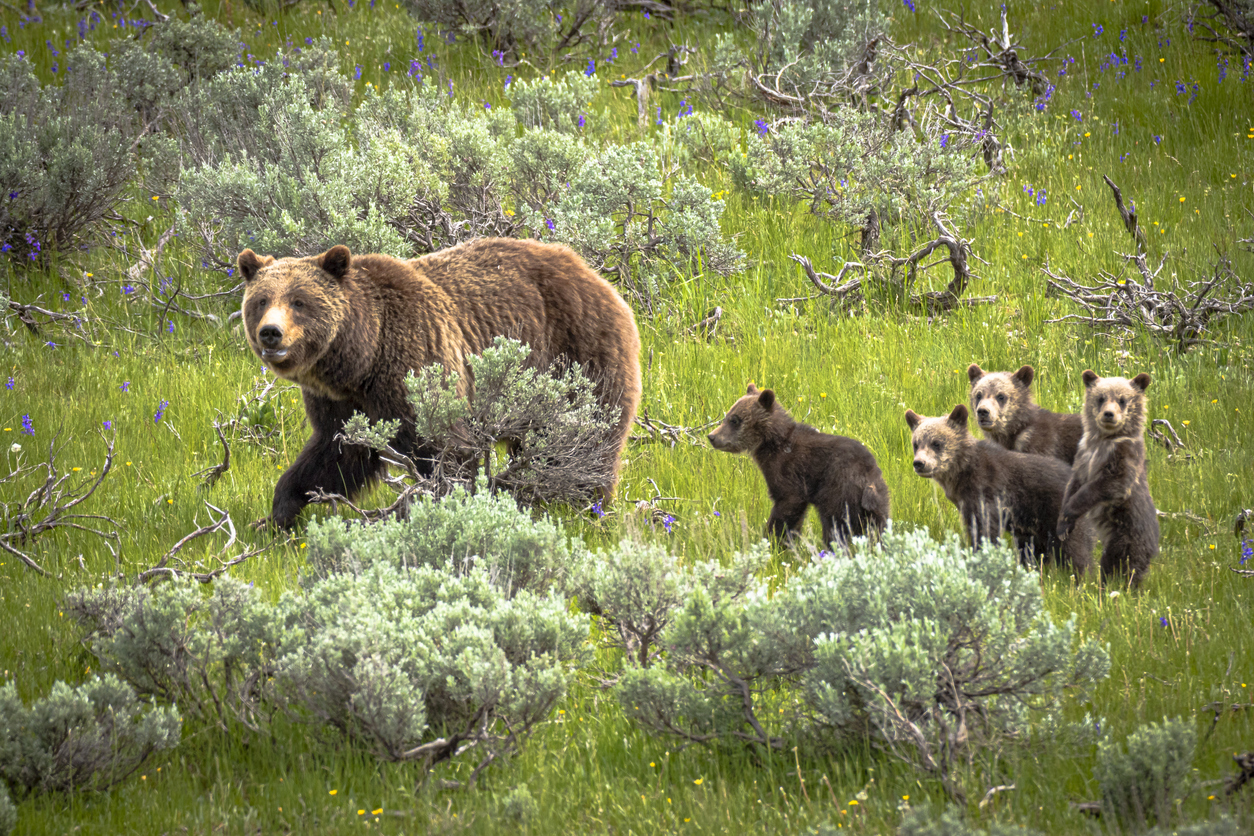
What do we restore in ourselves when we bring back wild animals like grizzly bears? A balance of top predators on our land, a mature relationship of respect with other creatures, a harmonious understanding that we need the wild, both in our ecosystems and in our imaginations.
Bears continue to roam our imaginations. Every year, I work at my desk with one screen focused on www.Explore.org’s live Bear Cam at Alaska’s Brooks Falls. The sight of mother brown bears teaching playful cubs to catch salmon, as the scarlet fish leap up the waterfall, accompanied by a soundtrack of seagulls and rushing water, is a Zen-like accompaniment to computer-bound days. In 2022, a wildlife camera, this time in Boulder, Colorado, accidentally captured hundreds of “bear selfies” that quickly went viral. Though there are no known grizzlies in Colorado, the usually solitary and elusive black bear, one of 17,000–20,000 in the state, was caught “preening, posing, and cavorting for the camera like a diva, seemingly taking a cue from Madonna.”
As much as bears teach us about rest and play, they also sometimes offer comic relief, whether it’s the eternal Yogi Bear of cartoons, Winnie the Pooh, or the surprise smash hit, Cocaine Bears, a ridiculous and hilarious film based on a true story. In it, a 500-pound black bear on an island in Georgia gobbles an illegal drug stash and runs roughshod over the clueless campers. My friends Tracey, John, Greg and I emerged from our pandemic hibernation midwinter and delightedly streamed the antics of this CGI-enhanced, coked-up bear. Like an anti-superhero, the bear romped over people’s tents and territories to reclaim the forest. It was like watching Smokey Bear go full-on demonic Joker. None of us could remember laughing so uproariously since before the pandemic.
The Great Bear still occupies a primal place in our human stories. A sort of genetic cue or reminder from our ancestors who knew the power of top-predator peers, bears are darkly comic and playful, cuddling our children yet capable of casually killing people with the swat of a huge paw, just like that long-ago grizzly who coveted my grandmother’s rich apple butter—but decided to let us live.

